Risk Management and Hazard Control: Outdoor Timber Company OSH Report
VerifiedAdded on 2022/09/22
|20
|4373
|25
Report
AI Summary
This report, prepared for Outdoor Timber, a woodworking company, addresses the design of a comprehensive occupational safety and health (OSH) risk management system. The report begins by outlining the critical steps in risk management, including hazard identification, risk assessment, and control measures, emphasizing the importance of these processes for mitigating workplace hazards. It then describes the duties of Outdoor Timber and Timber Painters, focusing on hazard identification and control, particularly concerning the handling of CCA-treated timber and the use of paints. The report further details hazard identification methods, such as reviewing merchandise information and considering the human factor, and applies these methods to the specific context of the company's operations. It includes an analysis of the highest risks, considering factors such as equipment use and material handling. Finally, the report explains the hierarchy of controls and proposes specific control measures for identified hazards, ensuring a safer workplace environment and compliance with New Zealand OSH regulations.
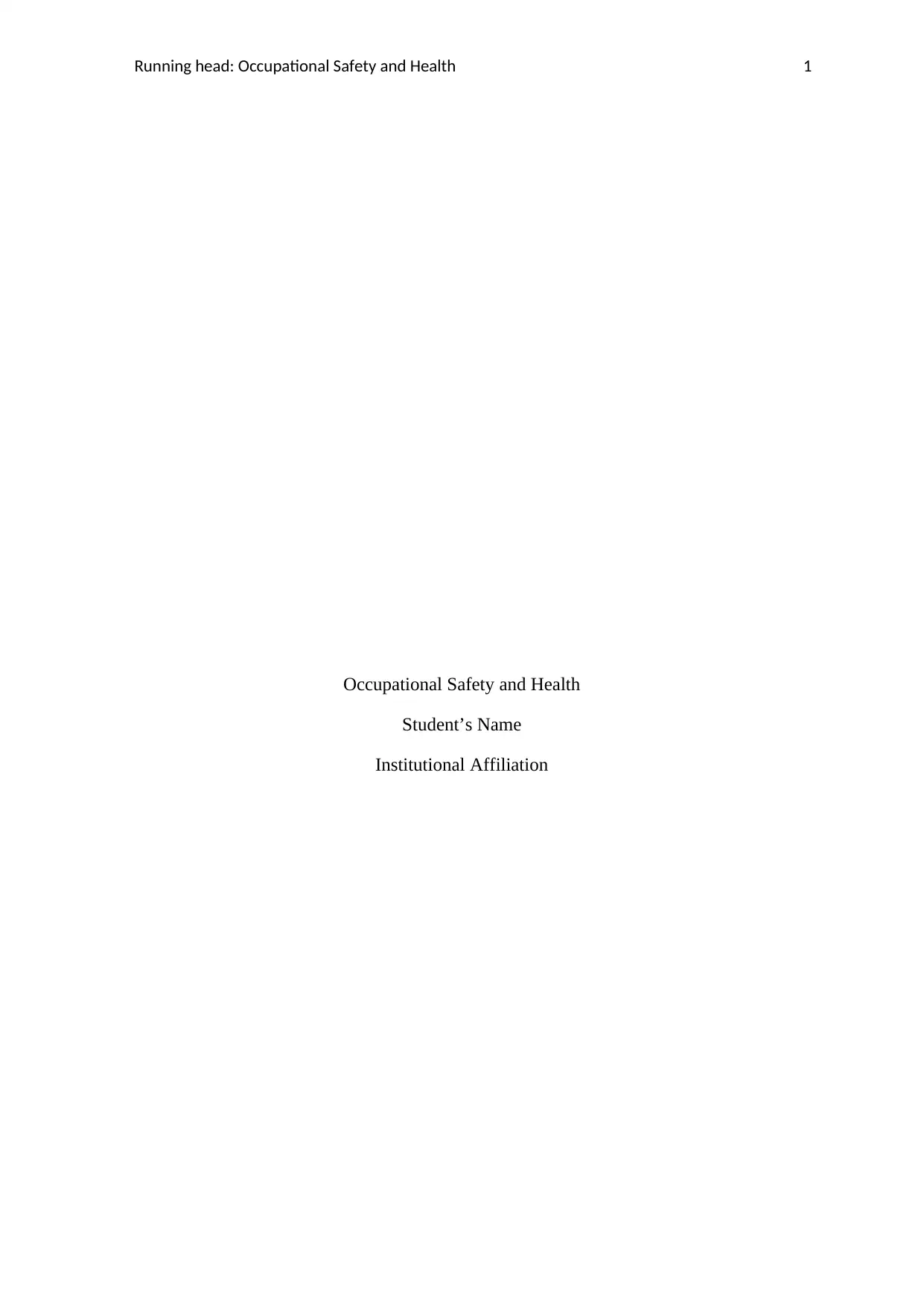
Running head: Occupational Safety and Health 1
Occupational Safety and Health
Student’s Name
Institutional Affiliation
Occupational Safety and Health
Student’s Name
Institutional Affiliation
Paraphrase This Document
Need a fresh take? Get an instant paraphrase of this document with our AI Paraphraser
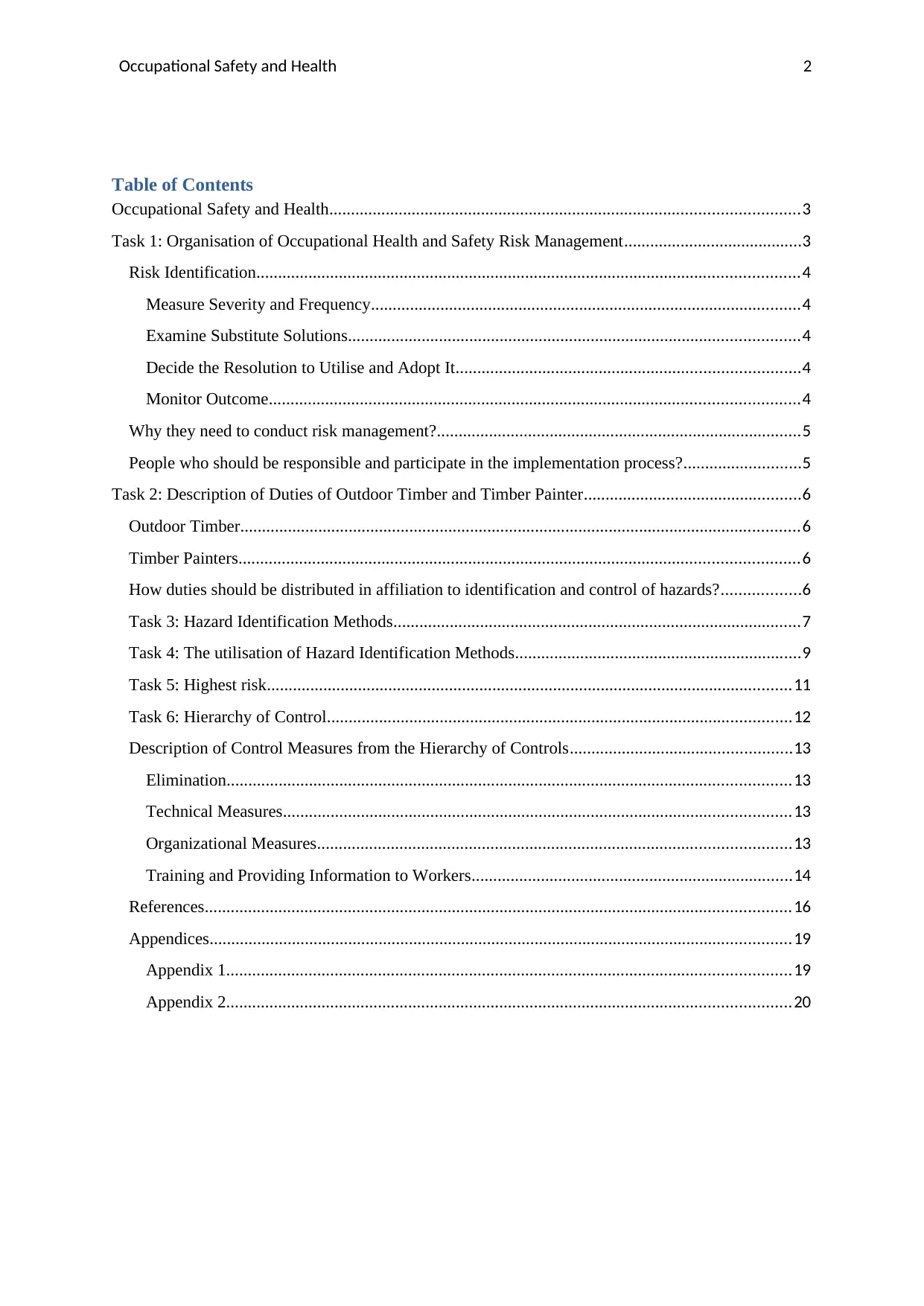
Occupational Safety and Health 2
Table of Contents
Occupational Safety and Health............................................................................................................3
Task 1: Organisation of Occupational Health and Safety Risk Management.........................................3
Risk Identification.............................................................................................................................4
Measure Severity and Frequency...................................................................................................4
Examine Substitute Solutions........................................................................................................4
Decide the Resolution to Utilise and Adopt It...............................................................................4
Monitor Outcome..........................................................................................................................4
Why they need to conduct risk management?....................................................................................5
People who should be responsible and participate in the implementation process?...........................5
Task 2: Description of Duties of Outdoor Timber and Timber Painter..................................................6
Outdoor Timber.................................................................................................................................6
Timber Painters.................................................................................................................................6
How duties should be distributed in affiliation to identification and control of hazards?..................6
Task 3: Hazard Identification Methods..............................................................................................7
Task 4: The utilisation of Hazard Identification Methods..................................................................9
Task 5: Highest risk.........................................................................................................................11
Task 6: Hierarchy of Control...........................................................................................................12
Description of Control Measures from the Hierarchy of Controls...................................................13
Elimination..................................................................................................................................13
Technical Measures.....................................................................................................................13
Organizational Measures.............................................................................................................13
Training and Providing Information to Workers..........................................................................14
References.......................................................................................................................................16
Appendices......................................................................................................................................19
Appendix 1..................................................................................................................................19
Appendix 2..................................................................................................................................20
Table of Contents
Occupational Safety and Health............................................................................................................3
Task 1: Organisation of Occupational Health and Safety Risk Management.........................................3
Risk Identification.............................................................................................................................4
Measure Severity and Frequency...................................................................................................4
Examine Substitute Solutions........................................................................................................4
Decide the Resolution to Utilise and Adopt It...............................................................................4
Monitor Outcome..........................................................................................................................4
Why they need to conduct risk management?....................................................................................5
People who should be responsible and participate in the implementation process?...........................5
Task 2: Description of Duties of Outdoor Timber and Timber Painter..................................................6
Outdoor Timber.................................................................................................................................6
Timber Painters.................................................................................................................................6
How duties should be distributed in affiliation to identification and control of hazards?..................6
Task 3: Hazard Identification Methods..............................................................................................7
Task 4: The utilisation of Hazard Identification Methods..................................................................9
Task 5: Highest risk.........................................................................................................................11
Task 6: Hierarchy of Control...........................................................................................................12
Description of Control Measures from the Hierarchy of Controls...................................................13
Elimination..................................................................................................................................13
Technical Measures.....................................................................................................................13
Organizational Measures.............................................................................................................13
Training and Providing Information to Workers..........................................................................14
References.......................................................................................................................................16
Appendices......................................................................................................................................19
Appendix 1..................................................................................................................................19
Appendix 2..................................................................................................................................20
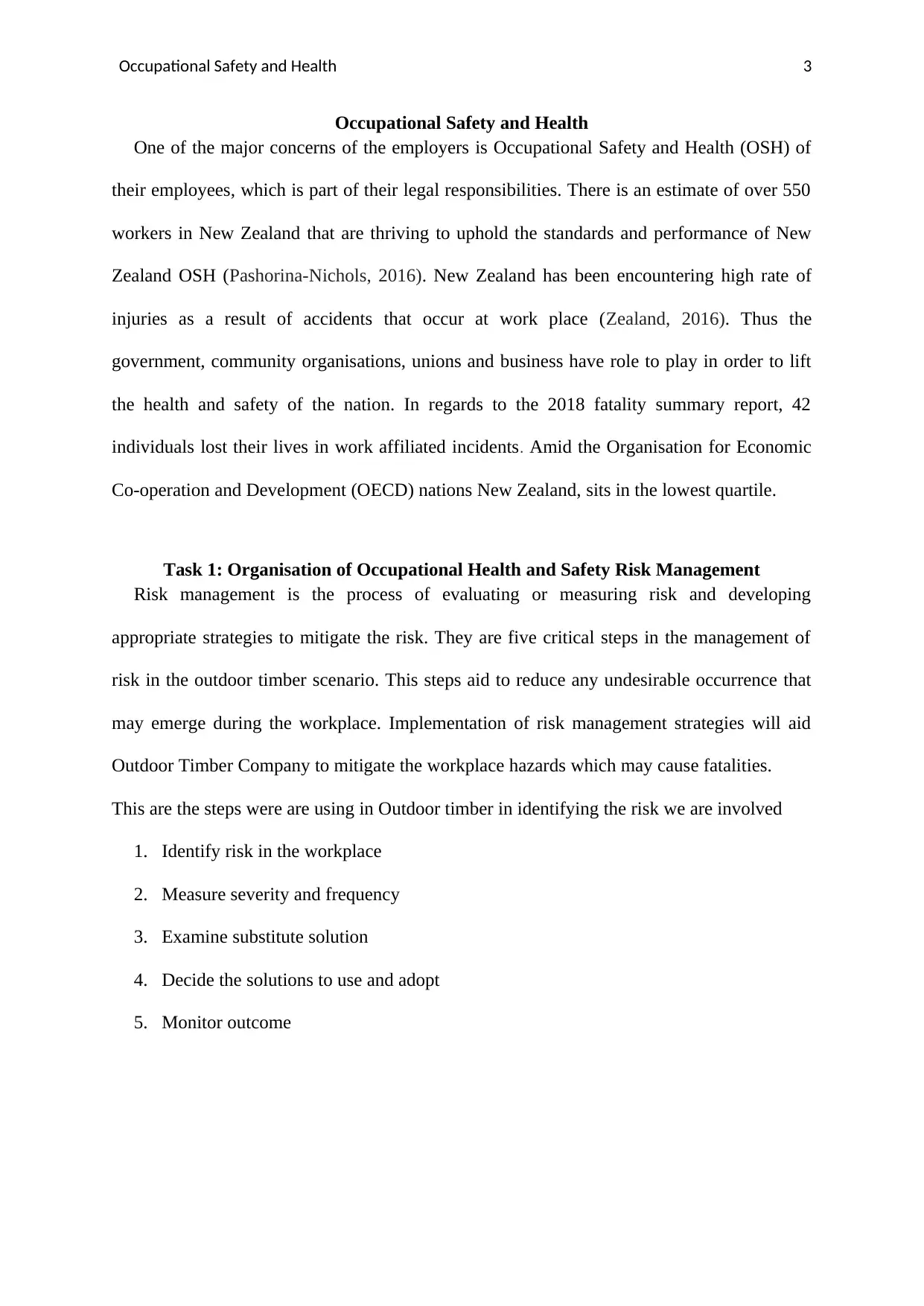
Occupational Safety and Health 3
Occupational Safety and Health
One of the major concerns of the employers is Occupational Safety and Health (OSH) of
their employees, which is part of their legal responsibilities. There is an estimate of over 550
workers in New Zealand that are thriving to uphold the standards and performance of New
Zealand OSH (Pashorina-Nichols, 2016). New Zealand has been encountering high rate of
injuries as a result of accidents that occur at work place (Zealand, 2016). Thus the
government, community organisations, unions and business have role to play in order to lift
the health and safety of the nation. In regards to the 2018 fatality summary report, 42
individuals lost their lives in work affiliated incidents. Amid the Organisation for Economic
Co-operation and Development (OECD) nations New Zealand, sits in the lowest quartile.
Task 1: Organisation of Occupational Health and Safety Risk Management
Risk management is the process of evaluating or measuring risk and developing
appropriate strategies to mitigate the risk. They are five critical steps in the management of
risk in the outdoor timber scenario. This steps aid to reduce any undesirable occurrence that
may emerge during the workplace. Implementation of risk management strategies will aid
Outdoor Timber Company to mitigate the workplace hazards which may cause fatalities.
This are the steps were are using in Outdoor timber in identifying the risk we are involved
1. Identify risk in the workplace
2. Measure severity and frequency
3. Examine substitute solution
4. Decide the solutions to use and adopt
5. Monitor outcome
Occupational Safety and Health
One of the major concerns of the employers is Occupational Safety and Health (OSH) of
their employees, which is part of their legal responsibilities. There is an estimate of over 550
workers in New Zealand that are thriving to uphold the standards and performance of New
Zealand OSH (Pashorina-Nichols, 2016). New Zealand has been encountering high rate of
injuries as a result of accidents that occur at work place (Zealand, 2016). Thus the
government, community organisations, unions and business have role to play in order to lift
the health and safety of the nation. In regards to the 2018 fatality summary report, 42
individuals lost their lives in work affiliated incidents. Amid the Organisation for Economic
Co-operation and Development (OECD) nations New Zealand, sits in the lowest quartile.
Task 1: Organisation of Occupational Health and Safety Risk Management
Risk management is the process of evaluating or measuring risk and developing
appropriate strategies to mitigate the risk. They are five critical steps in the management of
risk in the outdoor timber scenario. This steps aid to reduce any undesirable occurrence that
may emerge during the workplace. Implementation of risk management strategies will aid
Outdoor Timber Company to mitigate the workplace hazards which may cause fatalities.
This are the steps were are using in Outdoor timber in identifying the risk we are involved
1. Identify risk in the workplace
2. Measure severity and frequency
3. Examine substitute solution
4. Decide the solutions to use and adopt
5. Monitor outcome
⊘ This is a preview!⊘
Do you want full access?
Subscribe today to unlock all pages.

Trusted by 1+ million students worldwide
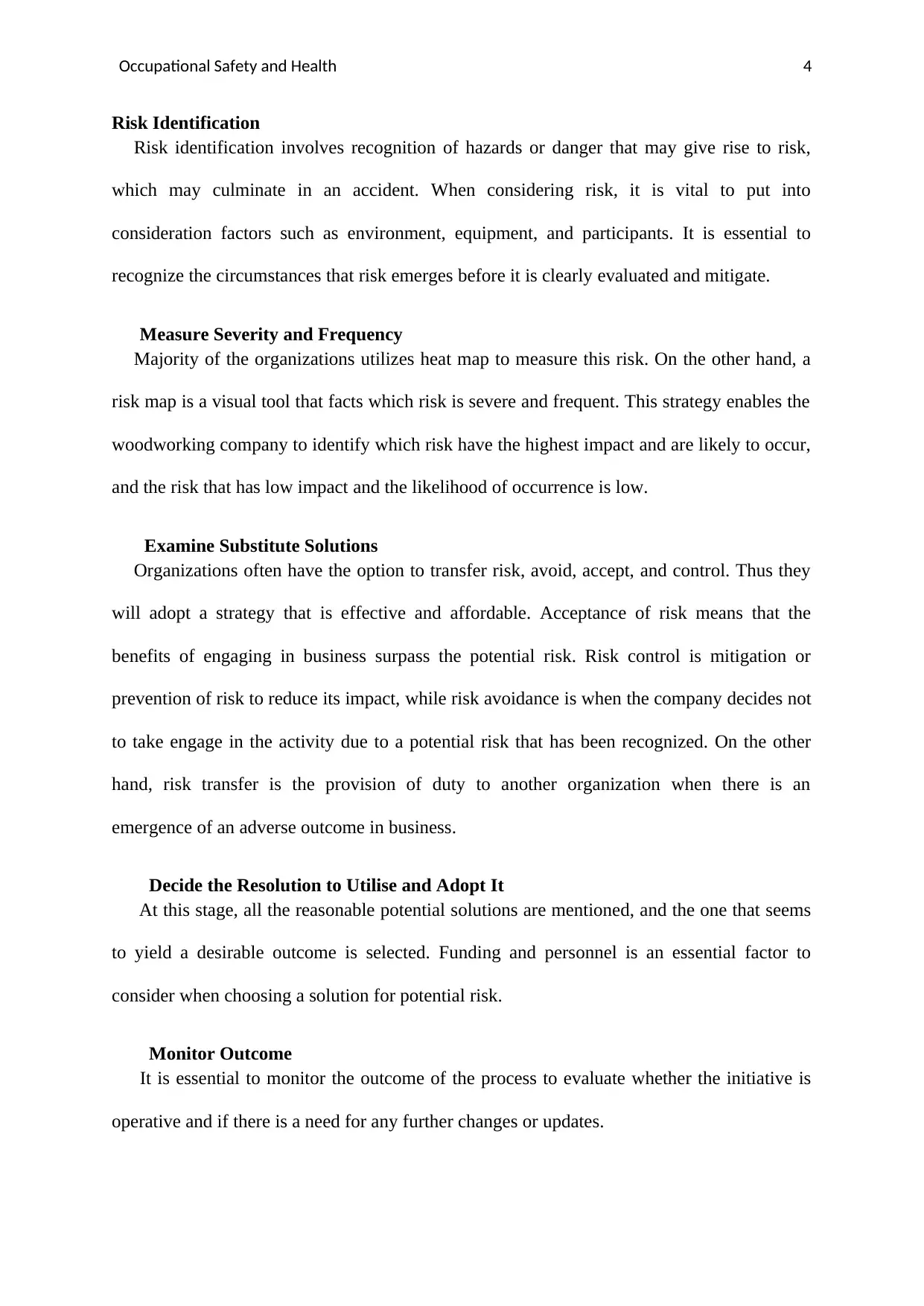
Occupational Safety and Health 4
Risk Identification
Risk identification involves recognition of hazards or danger that may give rise to risk,
which may culminate in an accident. When considering risk, it is vital to put into
consideration factors such as environment, equipment, and participants. It is essential to
recognize the circumstances that risk emerges before it is clearly evaluated and mitigate.
Measure Severity and Frequency
Majority of the organizations utilizes heat map to measure this risk. On the other hand, a
risk map is a visual tool that facts which risk is severe and frequent. This strategy enables the
woodworking company to identify which risk have the highest impact and are likely to occur,
and the risk that has low impact and the likelihood of occurrence is low.
Examine Substitute Solutions
Organizations often have the option to transfer risk, avoid, accept, and control. Thus they
will adopt a strategy that is effective and affordable. Acceptance of risk means that the
benefits of engaging in business surpass the potential risk. Risk control is mitigation or
prevention of risk to reduce its impact, while risk avoidance is when the company decides not
to take engage in the activity due to a potential risk that has been recognized. On the other
hand, risk transfer is the provision of duty to another organization when there is an
emergence of an adverse outcome in business.
Decide the Resolution to Utilise and Adopt It
At this stage, all the reasonable potential solutions are mentioned, and the one that seems
to yield a desirable outcome is selected. Funding and personnel is an essential factor to
consider when choosing a solution for potential risk.
Monitor Outcome
It is essential to monitor the outcome of the process to evaluate whether the initiative is
operative and if there is a need for any further changes or updates.
Risk Identification
Risk identification involves recognition of hazards or danger that may give rise to risk,
which may culminate in an accident. When considering risk, it is vital to put into
consideration factors such as environment, equipment, and participants. It is essential to
recognize the circumstances that risk emerges before it is clearly evaluated and mitigate.
Measure Severity and Frequency
Majority of the organizations utilizes heat map to measure this risk. On the other hand, a
risk map is a visual tool that facts which risk is severe and frequent. This strategy enables the
woodworking company to identify which risk have the highest impact and are likely to occur,
and the risk that has low impact and the likelihood of occurrence is low.
Examine Substitute Solutions
Organizations often have the option to transfer risk, avoid, accept, and control. Thus they
will adopt a strategy that is effective and affordable. Acceptance of risk means that the
benefits of engaging in business surpass the potential risk. Risk control is mitigation or
prevention of risk to reduce its impact, while risk avoidance is when the company decides not
to take engage in the activity due to a potential risk that has been recognized. On the other
hand, risk transfer is the provision of duty to another organization when there is an
emergence of an adverse outcome in business.
Decide the Resolution to Utilise and Adopt It
At this stage, all the reasonable potential solutions are mentioned, and the one that seems
to yield a desirable outcome is selected. Funding and personnel is an essential factor to
consider when choosing a solution for potential risk.
Monitor Outcome
It is essential to monitor the outcome of the process to evaluate whether the initiative is
operative and if there is a need for any further changes or updates.
Paraphrase This Document
Need a fresh take? Get an instant paraphrase of this document with our AI Paraphraser
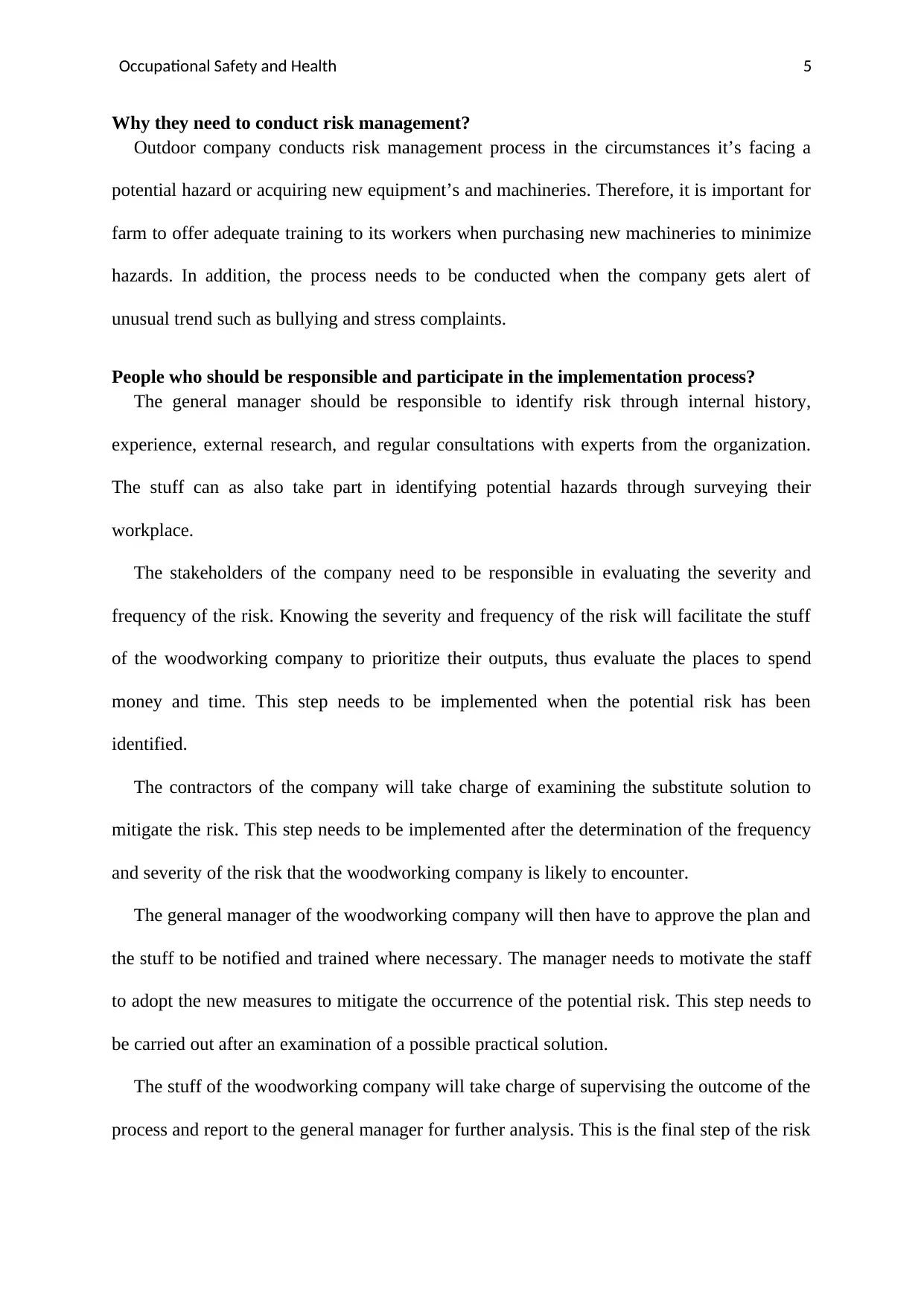
Occupational Safety and Health 5
Why they need to conduct risk management?
Outdoor company conducts risk management process in the circumstances it’s facing a
potential hazard or acquiring new equipment’s and machineries. Therefore, it is important for
farm to offer adequate training to its workers when purchasing new machineries to minimize
hazards. In addition, the process needs to be conducted when the company gets alert of
unusual trend such as bullying and stress complaints.
People who should be responsible and participate in the implementation process?
The general manager should be responsible to identify risk through internal history,
experience, external research, and regular consultations with experts from the organization.
The stuff can as also take part in identifying potential hazards through surveying their
workplace.
The stakeholders of the company need to be responsible in evaluating the severity and
frequency of the risk. Knowing the severity and frequency of the risk will facilitate the stuff
of the woodworking company to prioritize their outputs, thus evaluate the places to spend
money and time. This step needs to be implemented when the potential risk has been
identified.
The contractors of the company will take charge of examining the substitute solution to
mitigate the risk. This step needs to be implemented after the determination of the frequency
and severity of the risk that the woodworking company is likely to encounter.
The general manager of the woodworking company will then have to approve the plan and
the stuff to be notified and trained where necessary. The manager needs to motivate the staff
to adopt the new measures to mitigate the occurrence of the potential risk. This step needs to
be carried out after an examination of a possible practical solution.
The stuff of the woodworking company will take charge of supervising the outcome of the
process and report to the general manager for further analysis. This is the final step of the risk
Why they need to conduct risk management?
Outdoor company conducts risk management process in the circumstances it’s facing a
potential hazard or acquiring new equipment’s and machineries. Therefore, it is important for
farm to offer adequate training to its workers when purchasing new machineries to minimize
hazards. In addition, the process needs to be conducted when the company gets alert of
unusual trend such as bullying and stress complaints.
People who should be responsible and participate in the implementation process?
The general manager should be responsible to identify risk through internal history,
experience, external research, and regular consultations with experts from the organization.
The stuff can as also take part in identifying potential hazards through surveying their
workplace.
The stakeholders of the company need to be responsible in evaluating the severity and
frequency of the risk. Knowing the severity and frequency of the risk will facilitate the stuff
of the woodworking company to prioritize their outputs, thus evaluate the places to spend
money and time. This step needs to be implemented when the potential risk has been
identified.
The contractors of the company will take charge of examining the substitute solution to
mitigate the risk. This step needs to be implemented after the determination of the frequency
and severity of the risk that the woodworking company is likely to encounter.
The general manager of the woodworking company will then have to approve the plan and
the stuff to be notified and trained where necessary. The manager needs to motivate the staff
to adopt the new measures to mitigate the occurrence of the potential risk. This step needs to
be carried out after an examination of a possible practical solution.
The stuff of the woodworking company will take charge of supervising the outcome of the
process and report to the general manager for further analysis. This is the final step of the risk
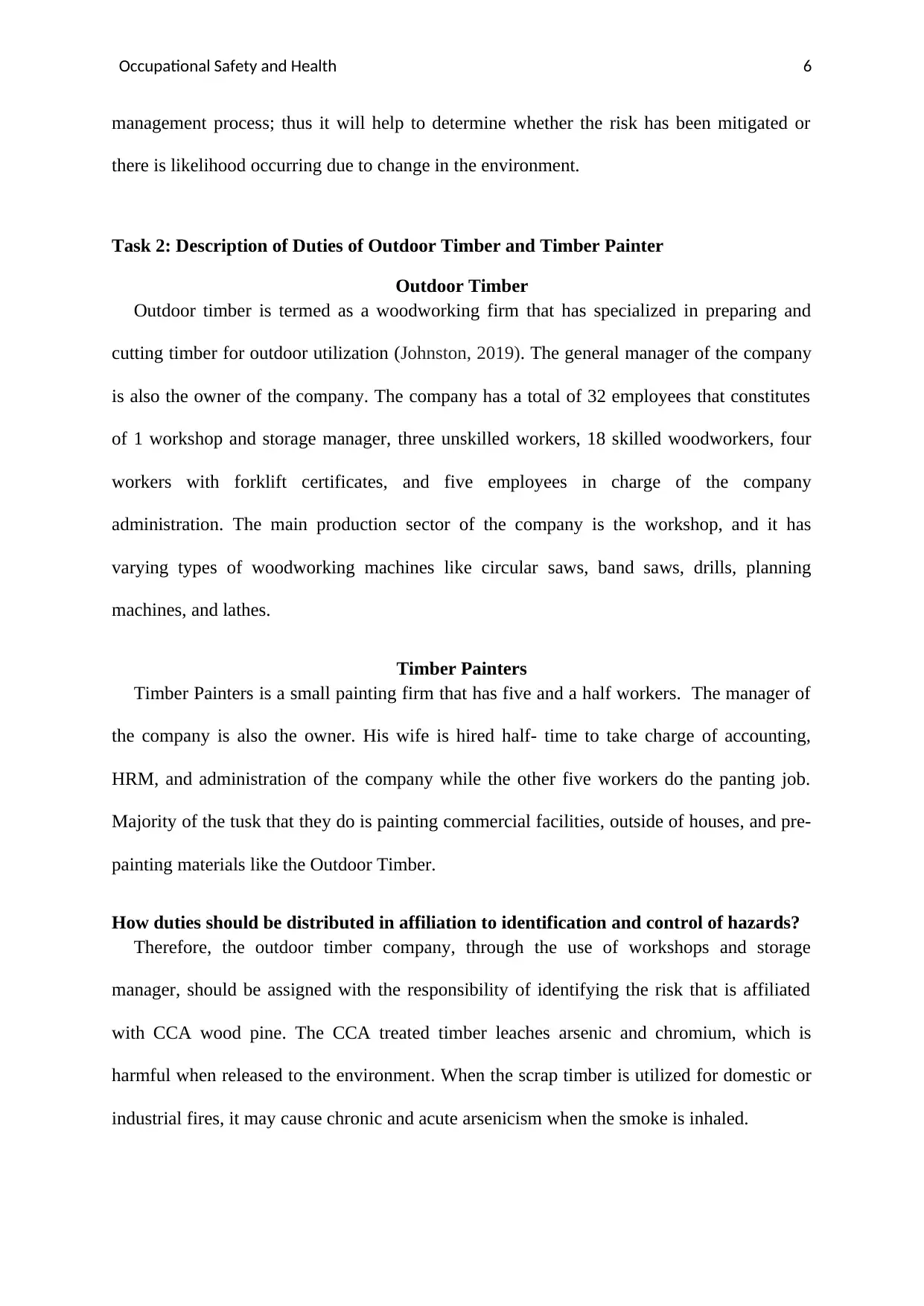
Occupational Safety and Health 6
management process; thus it will help to determine whether the risk has been mitigated or
there is likelihood occurring due to change in the environment.
Task 2: Description of Duties of Outdoor Timber and Timber Painter
Outdoor Timber
Outdoor timber is termed as a woodworking firm that has specialized in preparing and
cutting timber for outdoor utilization (Johnston, 2019). The general manager of the company
is also the owner of the company. The company has a total of 32 employees that constitutes
of 1 workshop and storage manager, three unskilled workers, 18 skilled woodworkers, four
workers with forklift certificates, and five employees in charge of the company
administration. The main production sector of the company is the workshop, and it has
varying types of woodworking machines like circular saws, band saws, drills, planning
machines, and lathes.
Timber Painters
Timber Painters is a small painting firm that has five and a half workers. The manager of
the company is also the owner. His wife is hired half- time to take charge of accounting,
HRM, and administration of the company while the other five workers do the panting job.
Majority of the tusk that they do is painting commercial facilities, outside of houses, and pre-
painting materials like the Outdoor Timber.
How duties should be distributed in affiliation to identification and control of hazards?
Therefore, the outdoor timber company, through the use of workshops and storage
manager, should be assigned with the responsibility of identifying the risk that is affiliated
with CCA wood pine. The CCA treated timber leaches arsenic and chromium, which is
harmful when released to the environment. When the scrap timber is utilized for domestic or
industrial fires, it may cause chronic and acute arsenicism when the smoke is inhaled.
management process; thus it will help to determine whether the risk has been mitigated or
there is likelihood occurring due to change in the environment.
Task 2: Description of Duties of Outdoor Timber and Timber Painter
Outdoor Timber
Outdoor timber is termed as a woodworking firm that has specialized in preparing and
cutting timber for outdoor utilization (Johnston, 2019). The general manager of the company
is also the owner of the company. The company has a total of 32 employees that constitutes
of 1 workshop and storage manager, three unskilled workers, 18 skilled woodworkers, four
workers with forklift certificates, and five employees in charge of the company
administration. The main production sector of the company is the workshop, and it has
varying types of woodworking machines like circular saws, band saws, drills, planning
machines, and lathes.
Timber Painters
Timber Painters is a small painting firm that has five and a half workers. The manager of
the company is also the owner. His wife is hired half- time to take charge of accounting,
HRM, and administration of the company while the other five workers do the panting job.
Majority of the tusk that they do is painting commercial facilities, outside of houses, and pre-
painting materials like the Outdoor Timber.
How duties should be distributed in affiliation to identification and control of hazards?
Therefore, the outdoor timber company, through the use of workshops and storage
manager, should be assigned with the responsibility of identifying the risk that is affiliated
with CCA wood pine. The CCA treated timber leaches arsenic and chromium, which is
harmful when released to the environment. When the scrap timber is utilized for domestic or
industrial fires, it may cause chronic and acute arsenicism when the smoke is inhaled.
⊘ This is a preview!⊘
Do you want full access?
Subscribe today to unlock all pages.

Trusted by 1+ million students worldwide
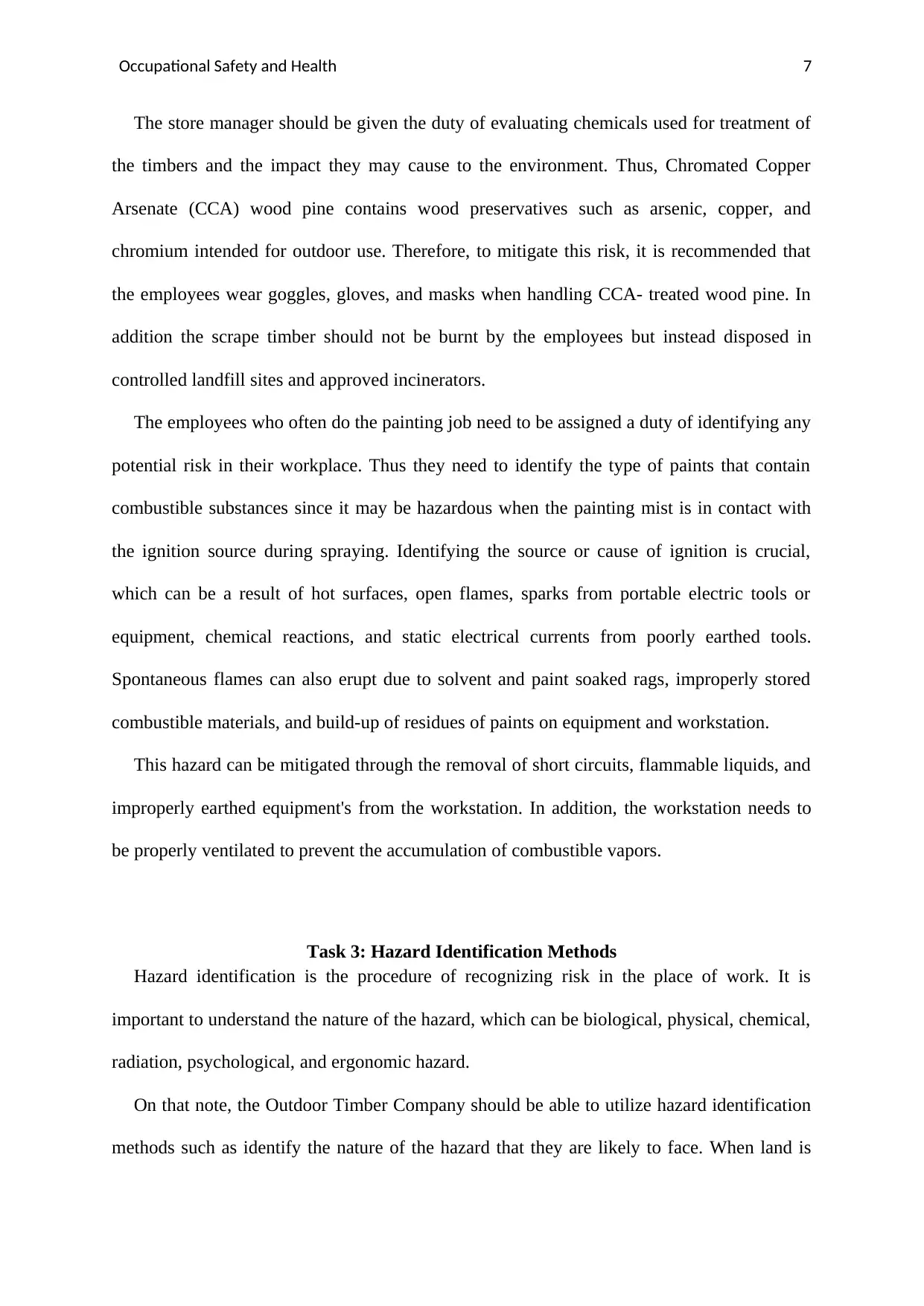
Occupational Safety and Health 7
The store manager should be given the duty of evaluating chemicals used for treatment of
the timbers and the impact they may cause to the environment. Thus, Chromated Copper
Arsenate (CCA) wood pine contains wood preservatives such as arsenic, copper, and
chromium intended for outdoor use. Therefore, to mitigate this risk, it is recommended that
the employees wear goggles, gloves, and masks when handling CCA- treated wood pine. In
addition the scrape timber should not be burnt by the employees but instead disposed in
controlled landfill sites and approved incinerators.
The employees who often do the painting job need to be assigned a duty of identifying any
potential risk in their workplace. Thus they need to identify the type of paints that contain
combustible substances since it may be hazardous when the painting mist is in contact with
the ignition source during spraying. Identifying the source or cause of ignition is crucial,
which can be a result of hot surfaces, open flames, sparks from portable electric tools or
equipment, chemical reactions, and static electrical currents from poorly earthed tools.
Spontaneous flames can also erupt due to solvent and paint soaked rags, improperly stored
combustible materials, and build-up of residues of paints on equipment and workstation.
This hazard can be mitigated through the removal of short circuits, flammable liquids, and
improperly earthed equipment's from the workstation. In addition, the workstation needs to
be properly ventilated to prevent the accumulation of combustible vapors.
Task 3: Hazard Identification Methods
Hazard identification is the procedure of recognizing risk in the place of work. It is
important to understand the nature of the hazard, which can be biological, physical, chemical,
radiation, psychological, and ergonomic hazard.
On that note, the Outdoor Timber Company should be able to utilize hazard identification
methods such as identify the nature of the hazard that they are likely to face. When land is
The store manager should be given the duty of evaluating chemicals used for treatment of
the timbers and the impact they may cause to the environment. Thus, Chromated Copper
Arsenate (CCA) wood pine contains wood preservatives such as arsenic, copper, and
chromium intended for outdoor use. Therefore, to mitigate this risk, it is recommended that
the employees wear goggles, gloves, and masks when handling CCA- treated wood pine. In
addition the scrape timber should not be burnt by the employees but instead disposed in
controlled landfill sites and approved incinerators.
The employees who often do the painting job need to be assigned a duty of identifying any
potential risk in their workplace. Thus they need to identify the type of paints that contain
combustible substances since it may be hazardous when the painting mist is in contact with
the ignition source during spraying. Identifying the source or cause of ignition is crucial,
which can be a result of hot surfaces, open flames, sparks from portable electric tools or
equipment, chemical reactions, and static electrical currents from poorly earthed tools.
Spontaneous flames can also erupt due to solvent and paint soaked rags, improperly stored
combustible materials, and build-up of residues of paints on equipment and workstation.
This hazard can be mitigated through the removal of short circuits, flammable liquids, and
improperly earthed equipment's from the workstation. In addition, the workstation needs to
be properly ventilated to prevent the accumulation of combustible vapors.
Task 3: Hazard Identification Methods
Hazard identification is the procedure of recognizing risk in the place of work. It is
important to understand the nature of the hazard, which can be biological, physical, chemical,
radiation, psychological, and ergonomic hazard.
On that note, the Outdoor Timber Company should be able to utilize hazard identification
methods such as identify the nature of the hazard that they are likely to face. When land is
Paraphrase This Document
Need a fresh take? Get an instant paraphrase of this document with our AI Paraphraser
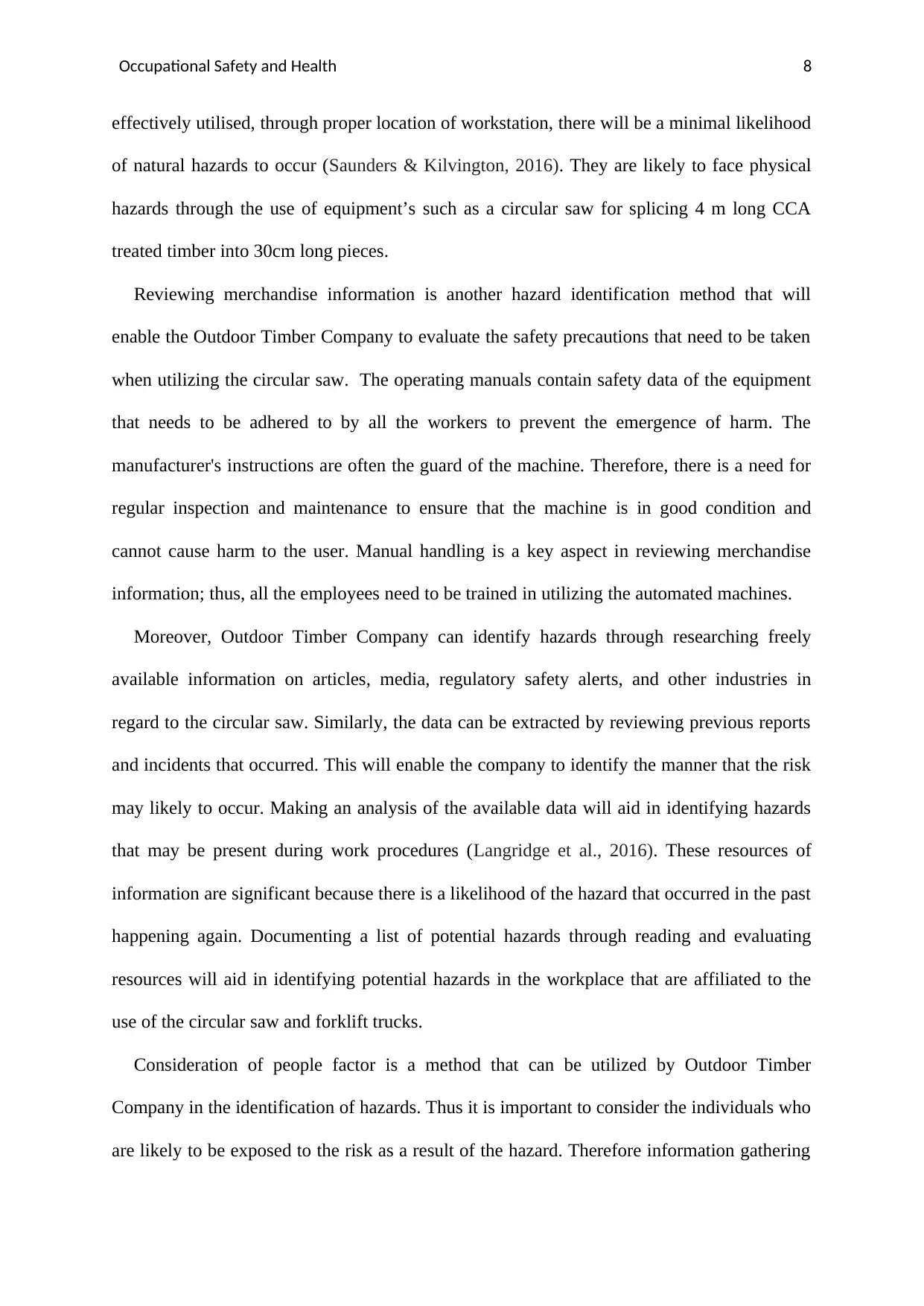
Occupational Safety and Health 8
effectively utilised, through proper location of workstation, there will be a minimal likelihood
of natural hazards to occur (Saunders & Kilvington, 2016). They are likely to face physical
hazards through the use of equipment’s such as a circular saw for splicing 4 m long CCA
treated timber into 30cm long pieces.
Reviewing merchandise information is another hazard identification method that will
enable the Outdoor Timber Company to evaluate the safety precautions that need to be taken
when utilizing the circular saw. The operating manuals contain safety data of the equipment
that needs to be adhered to by all the workers to prevent the emergence of harm. The
manufacturer's instructions are often the guard of the machine. Therefore, there is a need for
regular inspection and maintenance to ensure that the machine is in good condition and
cannot cause harm to the user. Manual handling is a key aspect in reviewing merchandise
information; thus, all the employees need to be trained in utilizing the automated machines.
Moreover, Outdoor Timber Company can identify hazards through researching freely
available information on articles, media, regulatory safety alerts, and other industries in
regard to the circular saw. Similarly, the data can be extracted by reviewing previous reports
and incidents that occurred. This will enable the company to identify the manner that the risk
may likely to occur. Making an analysis of the available data will aid in identifying hazards
that may be present during work procedures (Langridge et al., 2016). These resources of
information are significant because there is a likelihood of the hazard that occurred in the past
happening again. Documenting a list of potential hazards through reading and evaluating
resources will aid in identifying potential hazards in the workplace that are affiliated to the
use of the circular saw and forklift trucks.
Consideration of people factor is a method that can be utilized by Outdoor Timber
Company in the identification of hazards. Thus it is important to consider the individuals who
are likely to be exposed to the risk as a result of the hazard. Therefore information gathering
effectively utilised, through proper location of workstation, there will be a minimal likelihood
of natural hazards to occur (Saunders & Kilvington, 2016). They are likely to face physical
hazards through the use of equipment’s such as a circular saw for splicing 4 m long CCA
treated timber into 30cm long pieces.
Reviewing merchandise information is another hazard identification method that will
enable the Outdoor Timber Company to evaluate the safety precautions that need to be taken
when utilizing the circular saw. The operating manuals contain safety data of the equipment
that needs to be adhered to by all the workers to prevent the emergence of harm. The
manufacturer's instructions are often the guard of the machine. Therefore, there is a need for
regular inspection and maintenance to ensure that the machine is in good condition and
cannot cause harm to the user. Manual handling is a key aspect in reviewing merchandise
information; thus, all the employees need to be trained in utilizing the automated machines.
Moreover, Outdoor Timber Company can identify hazards through researching freely
available information on articles, media, regulatory safety alerts, and other industries in
regard to the circular saw. Similarly, the data can be extracted by reviewing previous reports
and incidents that occurred. This will enable the company to identify the manner that the risk
may likely to occur. Making an analysis of the available data will aid in identifying hazards
that may be present during work procedures (Langridge et al., 2016). These resources of
information are significant because there is a likelihood of the hazard that occurred in the past
happening again. Documenting a list of potential hazards through reading and evaluating
resources will aid in identifying potential hazards in the workplace that are affiliated to the
use of the circular saw and forklift trucks.
Consideration of people factor is a method that can be utilized by Outdoor Timber
Company in the identification of hazards. Thus it is important to consider the individuals who
are likely to be exposed to the risk as a result of the hazard. Therefore information gathering
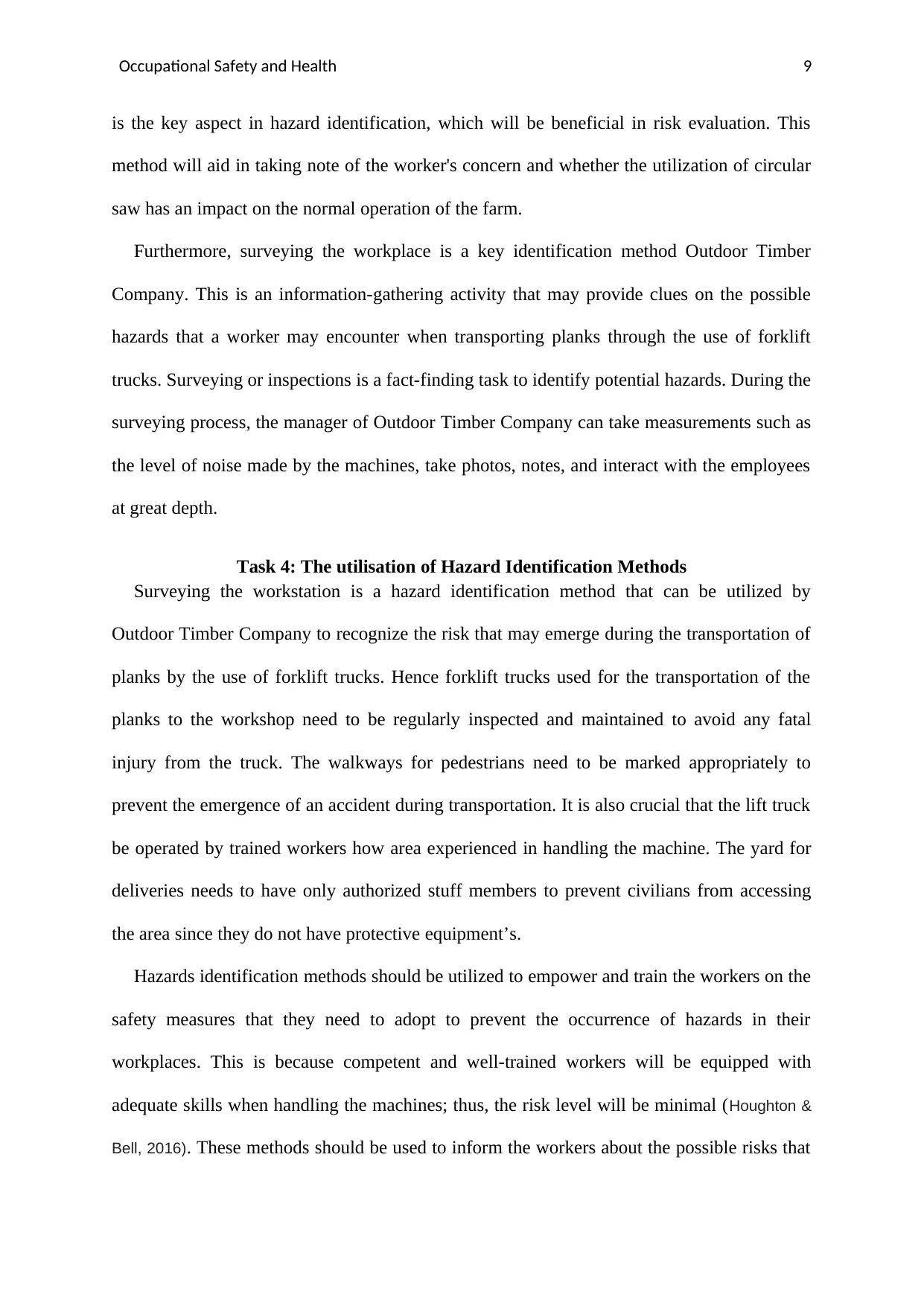
Occupational Safety and Health 9
is the key aspect in hazard identification, which will be beneficial in risk evaluation. This
method will aid in taking note of the worker's concern and whether the utilization of circular
saw has an impact on the normal operation of the farm.
Furthermore, surveying the workplace is a key identification method Outdoor Timber
Company. This is an information-gathering activity that may provide clues on the possible
hazards that a worker may encounter when transporting planks through the use of forklift
trucks. Surveying or inspections is a fact-finding task to identify potential hazards. During the
surveying process, the manager of Outdoor Timber Company can take measurements such as
the level of noise made by the machines, take photos, notes, and interact with the employees
at great depth.
Task 4: The utilisation of Hazard Identification Methods
Surveying the workstation is a hazard identification method that can be utilized by
Outdoor Timber Company to recognize the risk that may emerge during the transportation of
planks by the use of forklift trucks. Hence forklift trucks used for the transportation of the
planks to the workshop need to be regularly inspected and maintained to avoid any fatal
injury from the truck. The walkways for pedestrians need to be marked appropriately to
prevent the emergence of an accident during transportation. It is also crucial that the lift truck
be operated by trained workers how area experienced in handling the machine. The yard for
deliveries needs to have only authorized stuff members to prevent civilians from accessing
the area since they do not have protective equipment’s.
Hazards identification methods should be utilized to empower and train the workers on the
safety measures that they need to adopt to prevent the occurrence of hazards in their
workplaces. This is because competent and well-trained workers will be equipped with
adequate skills when handling the machines; thus, the risk level will be minimal (Houghton &
Bell, 2016). These methods should be used to inform the workers about the possible risks that
is the key aspect in hazard identification, which will be beneficial in risk evaluation. This
method will aid in taking note of the worker's concern and whether the utilization of circular
saw has an impact on the normal operation of the farm.
Furthermore, surveying the workplace is a key identification method Outdoor Timber
Company. This is an information-gathering activity that may provide clues on the possible
hazards that a worker may encounter when transporting planks through the use of forklift
trucks. Surveying or inspections is a fact-finding task to identify potential hazards. During the
surveying process, the manager of Outdoor Timber Company can take measurements such as
the level of noise made by the machines, take photos, notes, and interact with the employees
at great depth.
Task 4: The utilisation of Hazard Identification Methods
Surveying the workstation is a hazard identification method that can be utilized by
Outdoor Timber Company to recognize the risk that may emerge during the transportation of
planks by the use of forklift trucks. Hence forklift trucks used for the transportation of the
planks to the workshop need to be regularly inspected and maintained to avoid any fatal
injury from the truck. The walkways for pedestrians need to be marked appropriately to
prevent the emergence of an accident during transportation. It is also crucial that the lift truck
be operated by trained workers how area experienced in handling the machine. The yard for
deliveries needs to have only authorized stuff members to prevent civilians from accessing
the area since they do not have protective equipment’s.
Hazards identification methods should be utilized to empower and train the workers on the
safety measures that they need to adopt to prevent the occurrence of hazards in their
workplaces. This is because competent and well-trained workers will be equipped with
adequate skills when handling the machines; thus, the risk level will be minimal (Houghton &
Bell, 2016). These methods should be used to inform the workers about the possible risks that
⊘ This is a preview!⊘
Do you want full access?
Subscribe today to unlock all pages.

Trusted by 1+ million students worldwide
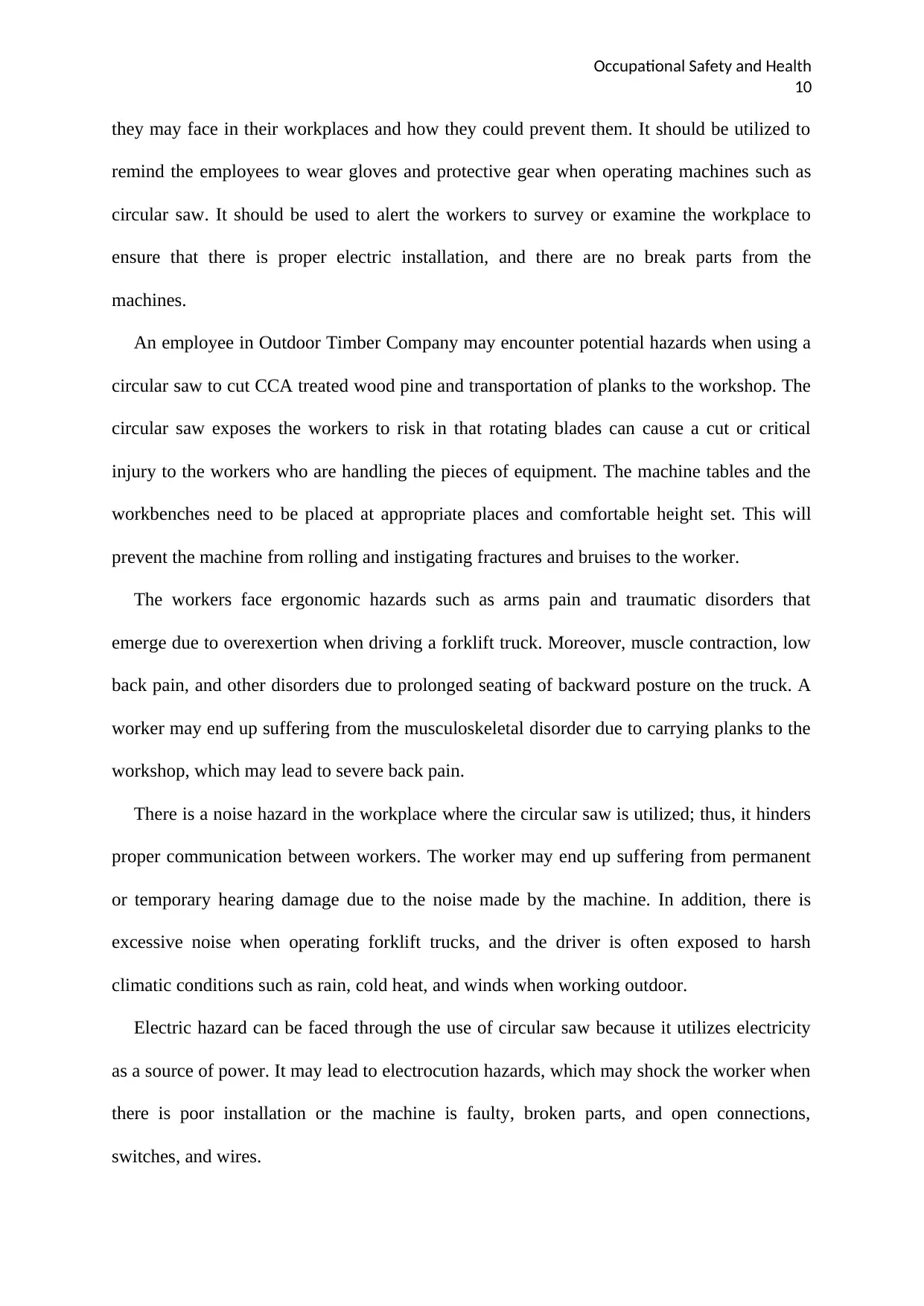
Occupational Safety and Health
10
they may face in their workplaces and how they could prevent them. It should be utilized to
remind the employees to wear gloves and protective gear when operating machines such as
circular saw. It should be used to alert the workers to survey or examine the workplace to
ensure that there is proper electric installation, and there are no break parts from the
machines.
An employee in Outdoor Timber Company may encounter potential hazards when using a
circular saw to cut CCA treated wood pine and transportation of planks to the workshop. The
circular saw exposes the workers to risk in that rotating blades can cause a cut or critical
injury to the workers who are handling the pieces of equipment. The machine tables and the
workbenches need to be placed at appropriate places and comfortable height set. This will
prevent the machine from rolling and instigating fractures and bruises to the worker.
The workers face ergonomic hazards such as arms pain and traumatic disorders that
emerge due to overexertion when driving a forklift truck. Moreover, muscle contraction, low
back pain, and other disorders due to prolonged seating of backward posture on the truck. A
worker may end up suffering from the musculoskeletal disorder due to carrying planks to the
workshop, which may lead to severe back pain.
There is a noise hazard in the workplace where the circular saw is utilized; thus, it hinders
proper communication between workers. The worker may end up suffering from permanent
or temporary hearing damage due to the noise made by the machine. In addition, there is
excessive noise when operating forklift trucks, and the driver is often exposed to harsh
climatic conditions such as rain, cold heat, and winds when working outdoor.
Electric hazard can be faced through the use of circular saw because it utilizes electricity
as a source of power. It may lead to electrocution hazards, which may shock the worker when
there is poor installation or the machine is faulty, broken parts, and open connections,
switches, and wires.
10
they may face in their workplaces and how they could prevent them. It should be utilized to
remind the employees to wear gloves and protective gear when operating machines such as
circular saw. It should be used to alert the workers to survey or examine the workplace to
ensure that there is proper electric installation, and there are no break parts from the
machines.
An employee in Outdoor Timber Company may encounter potential hazards when using a
circular saw to cut CCA treated wood pine and transportation of planks to the workshop. The
circular saw exposes the workers to risk in that rotating blades can cause a cut or critical
injury to the workers who are handling the pieces of equipment. The machine tables and the
workbenches need to be placed at appropriate places and comfortable height set. This will
prevent the machine from rolling and instigating fractures and bruises to the worker.
The workers face ergonomic hazards such as arms pain and traumatic disorders that
emerge due to overexertion when driving a forklift truck. Moreover, muscle contraction, low
back pain, and other disorders due to prolonged seating of backward posture on the truck. A
worker may end up suffering from the musculoskeletal disorder due to carrying planks to the
workshop, which may lead to severe back pain.
There is a noise hazard in the workplace where the circular saw is utilized; thus, it hinders
proper communication between workers. The worker may end up suffering from permanent
or temporary hearing damage due to the noise made by the machine. In addition, there is
excessive noise when operating forklift trucks, and the driver is often exposed to harsh
climatic conditions such as rain, cold heat, and winds when working outdoor.
Electric hazard can be faced through the use of circular saw because it utilizes electricity
as a source of power. It may lead to electrocution hazards, which may shock the worker when
there is poor installation or the machine is faulty, broken parts, and open connections,
switches, and wires.
Paraphrase This Document
Need a fresh take? Get an instant paraphrase of this document with our AI Paraphraser
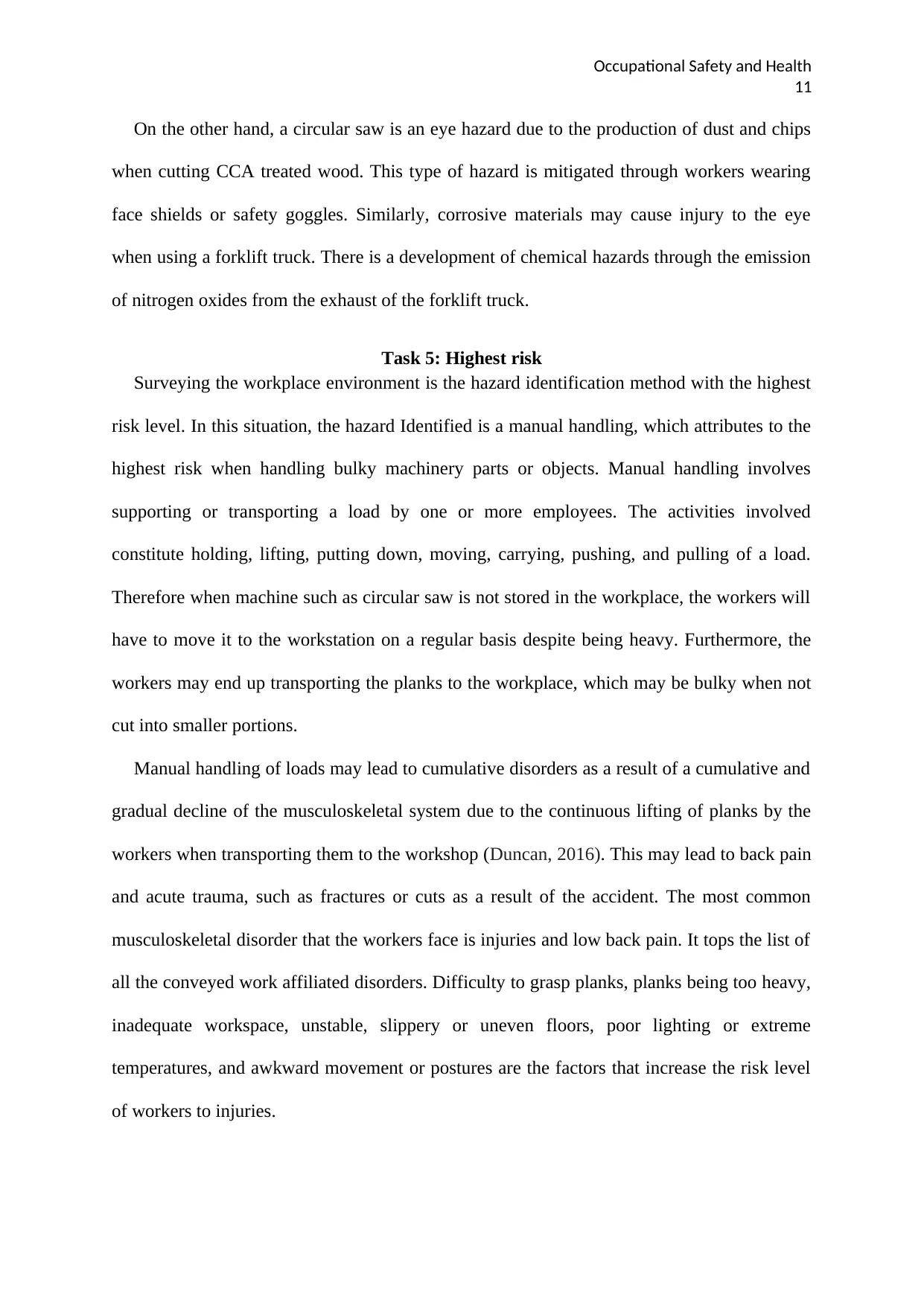
Occupational Safety and Health
11
On the other hand, a circular saw is an eye hazard due to the production of dust and chips
when cutting CCA treated wood. This type of hazard is mitigated through workers wearing
face shields or safety goggles. Similarly, corrosive materials may cause injury to the eye
when using a forklift truck. There is a development of chemical hazards through the emission
of nitrogen oxides from the exhaust of the forklift truck.
Task 5: Highest risk
Surveying the workplace environment is the hazard identification method with the highest
risk level. In this situation, the hazard Identified is a manual handling, which attributes to the
highest risk when handling bulky machinery parts or objects. Manual handling involves
supporting or transporting a load by one or more employees. The activities involved
constitute holding, lifting, putting down, moving, carrying, pushing, and pulling of a load.
Therefore when machine such as circular saw is not stored in the workplace, the workers will
have to move it to the workstation on a regular basis despite being heavy. Furthermore, the
workers may end up transporting the planks to the workplace, which may be bulky when not
cut into smaller portions.
Manual handling of loads may lead to cumulative disorders as a result of a cumulative and
gradual decline of the musculoskeletal system due to the continuous lifting of planks by the
workers when transporting them to the workshop (Duncan, 2016). This may lead to back pain
and acute trauma, such as fractures or cuts as a result of the accident. The most common
musculoskeletal disorder that the workers face is injuries and low back pain. It tops the list of
all the conveyed work affiliated disorders. Difficulty to grasp planks, planks being too heavy,
inadequate workspace, unstable, slippery or uneven floors, poor lighting or extreme
temperatures, and awkward movement or postures are the factors that increase the risk level
of workers to injuries.
11
On the other hand, a circular saw is an eye hazard due to the production of dust and chips
when cutting CCA treated wood. This type of hazard is mitigated through workers wearing
face shields or safety goggles. Similarly, corrosive materials may cause injury to the eye
when using a forklift truck. There is a development of chemical hazards through the emission
of nitrogen oxides from the exhaust of the forklift truck.
Task 5: Highest risk
Surveying the workplace environment is the hazard identification method with the highest
risk level. In this situation, the hazard Identified is a manual handling, which attributes to the
highest risk when handling bulky machinery parts or objects. Manual handling involves
supporting or transporting a load by one or more employees. The activities involved
constitute holding, lifting, putting down, moving, carrying, pushing, and pulling of a load.
Therefore when machine such as circular saw is not stored in the workplace, the workers will
have to move it to the workstation on a regular basis despite being heavy. Furthermore, the
workers may end up transporting the planks to the workplace, which may be bulky when not
cut into smaller portions.
Manual handling of loads may lead to cumulative disorders as a result of a cumulative and
gradual decline of the musculoskeletal system due to the continuous lifting of planks by the
workers when transporting them to the workshop (Duncan, 2016). This may lead to back pain
and acute trauma, such as fractures or cuts as a result of the accident. The most common
musculoskeletal disorder that the workers face is injuries and low back pain. It tops the list of
all the conveyed work affiliated disorders. Difficulty to grasp planks, planks being too heavy,
inadequate workspace, unstable, slippery or uneven floors, poor lighting or extreme
temperatures, and awkward movement or postures are the factors that increase the risk level
of workers to injuries.
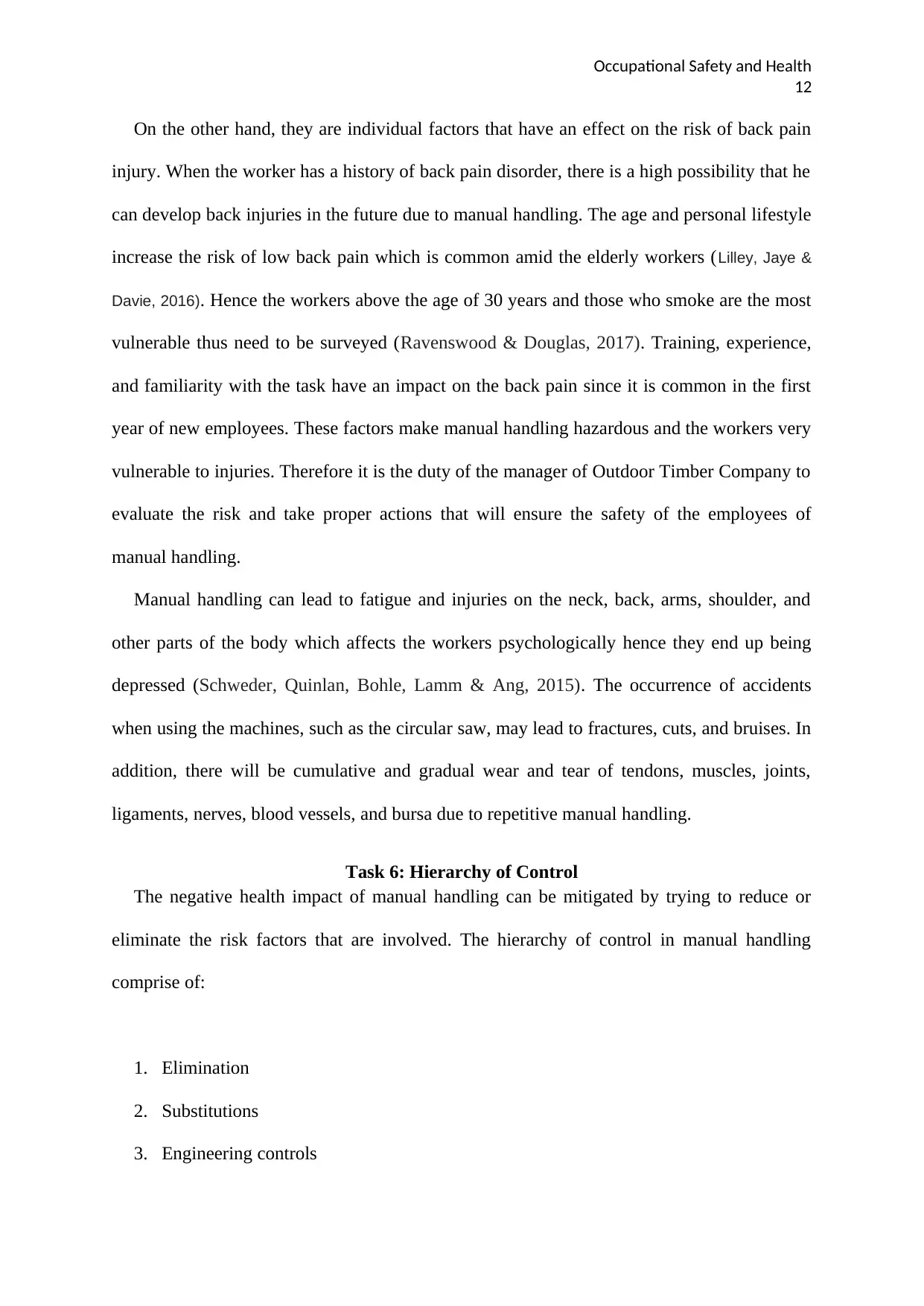
Occupational Safety and Health
12
On the other hand, they are individual factors that have an effect on the risk of back pain
injury. When the worker has a history of back pain disorder, there is a high possibility that he
can develop back injuries in the future due to manual handling. The age and personal lifestyle
increase the risk of low back pain which is common amid the elderly workers (Lilley, Jaye &
Davie, 2016). Hence the workers above the age of 30 years and those who smoke are the most
vulnerable thus need to be surveyed (Ravenswood & Douglas, 2017). Training, experience,
and familiarity with the task have an impact on the back pain since it is common in the first
year of new employees. These factors make manual handling hazardous and the workers very
vulnerable to injuries. Therefore it is the duty of the manager of Outdoor Timber Company to
evaluate the risk and take proper actions that will ensure the safety of the employees of
manual handling.
Manual handling can lead to fatigue and injuries on the neck, back, arms, shoulder, and
other parts of the body which affects the workers psychologically hence they end up being
depressed (Schweder, Quinlan, Bohle, Lamm & Ang, 2015). The occurrence of accidents
when using the machines, such as the circular saw, may lead to fractures, cuts, and bruises. In
addition, there will be cumulative and gradual wear and tear of tendons, muscles, joints,
ligaments, nerves, blood vessels, and bursa due to repetitive manual handling.
Task 6: Hierarchy of Control
The negative health impact of manual handling can be mitigated by trying to reduce or
eliminate the risk factors that are involved. The hierarchy of control in manual handling
comprise of:
1. Elimination
2. Substitutions
3. Engineering controls
12
On the other hand, they are individual factors that have an effect on the risk of back pain
injury. When the worker has a history of back pain disorder, there is a high possibility that he
can develop back injuries in the future due to manual handling. The age and personal lifestyle
increase the risk of low back pain which is common amid the elderly workers (Lilley, Jaye &
Davie, 2016). Hence the workers above the age of 30 years and those who smoke are the most
vulnerable thus need to be surveyed (Ravenswood & Douglas, 2017). Training, experience,
and familiarity with the task have an impact on the back pain since it is common in the first
year of new employees. These factors make manual handling hazardous and the workers very
vulnerable to injuries. Therefore it is the duty of the manager of Outdoor Timber Company to
evaluate the risk and take proper actions that will ensure the safety of the employees of
manual handling.
Manual handling can lead to fatigue and injuries on the neck, back, arms, shoulder, and
other parts of the body which affects the workers psychologically hence they end up being
depressed (Schweder, Quinlan, Bohle, Lamm & Ang, 2015). The occurrence of accidents
when using the machines, such as the circular saw, may lead to fractures, cuts, and bruises. In
addition, there will be cumulative and gradual wear and tear of tendons, muscles, joints,
ligaments, nerves, blood vessels, and bursa due to repetitive manual handling.
Task 6: Hierarchy of Control
The negative health impact of manual handling can be mitigated by trying to reduce or
eliminate the risk factors that are involved. The hierarchy of control in manual handling
comprise of:
1. Elimination
2. Substitutions
3. Engineering controls
⊘ This is a preview!⊘
Do you want full access?
Subscribe today to unlock all pages.

Trusted by 1+ million students worldwide
1 out of 20
Related Documents
Your All-in-One AI-Powered Toolkit for Academic Success.
+13062052269
info@desklib.com
Available 24*7 on WhatsApp / Email
![[object Object]](/_next/static/media/star-bottom.7253800d.svg)
Unlock your academic potential
Copyright © 2020–2025 A2Z Services. All Rights Reserved. Developed and managed by ZUCOL.





